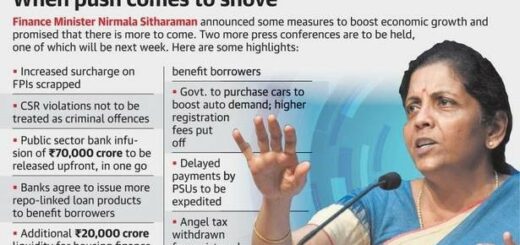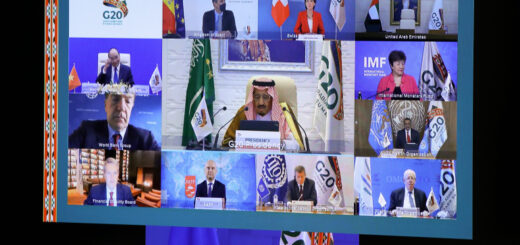National Current Affairs – UPSC/IAS Exams- 20th July 2019
Paramarsh Scheme
Topic: Government Policies
In News: The Union Minister for Human Resource Development, launched ‘Paramarsh’, a University Grants Commission (UGC) scheme.
More on the Topic:
- The scheme is for Mentoring National Accreditation and Assessment Council (NAAC) Accreditation Aspirant Institutions to promote Quality Assurance in Higher Education.
- The Scheme will be operationalized through a “Hub & Spoke” model wherein the Mentor Institution, called the “Hub” is centralized and will have the responsibility of guiding the Mentee institution through the secondary branches the “Spoke” through the services provided to the mentee for self improvement.
Expected Benefits:
- It will lead to enhancement of overall quality of the mentee institutions and enhance its profile as a result of improved quality of research, teaching and learning methodologies.
- It will help the mentee institution in getting NAAC accreditation.
- It will also facilitate the sharing of knowledge, information and opportunities for research collaboration and faculty development in Mentee Institutions.
- It will help in providing quality education to the 3.6 crore students who are enrolling to Indian Higher Education system at present.
About National Accreditation and Assessment Council:
- It was established in the year 1994 as an autonomous institution of the UGC with its Headquarter in Bengaluru.
- The mandate of NAAC is to make quality assurance an integral part of the functioning of HEIs.
- It makes arrangement for periodic assessment and accreditation of institutions of higher education or units thereof, or specific academic programmes or projects.
About University Grants Commission:
- The University Grants Commission (UGC) came into existence in 1953 and became a statutory organization of the Government of India by an Act of Parliament in 1956, for the coordination, determination and maintenance of standards of teaching, examination and research in university education.
Source: PIB, Wikipedia
SAGAR MAITRI Mission
Topic: Science and Technology
In News: Oceanographic research vessel of Defence Research and Development Organisation (DRDO), INS Sagardhwani, embarked on a two-month long SAGAR MAITRI (SM) Mission-2.
More on the Topic:
- SAGAR MAITRI is a unique initiative of DRDO which aligns with the broad objective of Prime Minister Shri Narendra Modi’s policy declaration “Safety And Growth for All in the Region (SAGAR)” to promote closer co-operation in socio-economic aspects as well as greater scientific interaction especially in ocean research among Indian Ocean Rim (IOR) countries.
- Under the aegis of PM’s policy, specific scientific component of DRDOis “MAITRI (Marine & Allied Interdisciplinary Training and Research Initiative)”.
- INS Sagardhwani has been designed and developed by Naval Physical and Oceanographic Laboratory (NPOL), a premier systems laboratory of DRDO. It conducts ocean research experiments in the Indian waters and spearheads NPOL’s at-sea data collection activities.
Mission Highlights:
- SAGAR MAITRIMission-2 commemorates the Golden Jubilee Celebrations of India’s lone research ship INS Kistna’s missions as part of the historic International Indian Ocean Expeditions(IIOE), which took place during 1962-65.
- As part of the mission, INS Sagardhwani will revisit the selected tracks of INS Kistna and provide NPOL scientists ample opportunities to collaborate and garner a close working relationship with the oceanographic counterparts of the IOR countries.
- The prime objectives of the SAGAR MAITRI Mission are data collection from the entire North Indian Ocean, focussing on the the Andaman Sea and adjoining seas and establishing long-term collaboration with eight IOR countries in the field of ocean research and development.
- The other IOR countries, include Oman, Maldives, Sri Lanka, Thailand, Malaysia, Singapore, Indonesia and Myanmar.
- The programme also aims at establishing long term scientific collaboration with these countries in the field of ‘Ocean Research & Development’ and data collection with a focus in the Andaman Sea.
Model Mains Question: Comment on the strategic importance of Indian Ocean region with respect to India.
Source: Hindu, wikipedia
Draft National Education Policy
Topic: Government Policies
In News: Draft NEP 2019 has been uploaded on MHRD’s website and also at innovate.mygov.in platform to elicit suggestions/comments from all stakeholders including the public, Government of India Ministries and State Governments. Around 65,000 suggestions and comments have been received and still being received from different stakeholders.
More on the Topic:
- The New Education Policy is designed to meet the changing dynamics of the requirements in terms of quality education, innovation and research.
- The policy aims at making India a knowledge superpower by equipping students with the necessary skills and knowledge.
- It also focusses on eliminating the shortage of manpower in science, technology, academics and industry.
- The Draft Policy is built on the foundational pillars of Access, Equity, Quality, Affordability and Accountability.
What are the key changes proposed?
- The committee has proposed to rename the Ministry of Human Resource Development as Ministry of Education (MoE). In school education, a major reconfiguration of curricular and pedagogical structure was proposed.
- The policy calls for an Early Childhood Care and Education (ECCE) as an integral part of school education. A 5+3+3+4 curricular and pedagogical structure based on cognitive and socio-emotional developmental stages of children was proposed.
- It consists of -Foundational Stage (age 3-8 yrs): 3 years of pre-primary plus Grades 1-2,Preparatory Stage (8-11 years): Grades 3-5,Middle Stage (11-14 years): Grades 6-8 and Secondary Stage (14-18 years): Grades 9-12
- The policy also seeks to reduce content load in school education curriculum.
- There will be no hard separation of learning areas in terms of curricular, co-curricular or extra- curricular areas. All subjects, including arts, music, crafts, sports, yoga, community service, etc will be part of the curricular.
- Thus, schools will be re-organized into school complexes. The policy promotes active pedagogy to focus on the development of core capacities and life skills, including 21st century skills.
- RTE Act: The committee recommends Extension of Right to Education Act 2009 to cover children of ages 3 to 18 (currently, 6-14).
- Teacher education: The committee proposes for massive transformation in teacher education. It calls for shutting down sub-standard teacher education institutions. It proposes moving all teacher preparation/education programmes into large multidisciplinary universities/colleges.
- The 4-year integrated stage-specific B.Ed. programme will eventually be the minimum degree qualification for teachers.
- Higher education: A restructuring of higher education institutions with three types of higher education institutions was proposed –
- Type 1: Focused on world-class research and high quality teaching, Type 2: Focused on high quality teaching across disciplines with significant contribution to research and Type 3: High quality teaching focused on undergraduate education
- This will be driven by two Missions –Mission Nalanda & Mission Takshashila.
- There will be re-structuring of Undergraduate programs such as BSc, BA, BCom, BVoc of 3 or 4 years duration and having multiple exit and entry options.
- Institution – A new apex body Rashtriya Shiksha Ayog is proposed.
- This is to enable a holistic and integrated implementation of all educational initiatives and programmatic interventions. The body will also coordinate efforts between the Centre and states.
- The National Research Foundation: an apex body, is proposed for creating a strong research culture.It will help build research capacity across higher education.
- The four functions of Standard Setting, Funding, Accreditation and Regulation will be separated and conducted by independent bodies.
- National Higher Education Regulatory Authority will be the only regulator for all higher education including professional education.
- The policy proposes to create an accreditation eco-system led by a revamped NAAC (National Assessment and Accreditation Council).
- Professional Standard Setting Bodies for each area of professional education was proposed.
- UGC is to be transformed to Higher Education Grants Commission (HEGC).
- The private and public institutions will be treated on par, and education will remain a ‘not for profit’ activity.
- Besides the above, the committee also recommended several new policy initiatives for -promoting internationalization of higher education,strengthening quality open and distance learning,technology integration at all levels of education,facilitating adult and lifelong learning,enhancing participation of under-represented groupseliminating gender, social category and regional gaps in education outcomes.
- Language: Promotion of Indian and classical languages and setting up three new National Institutes for Pali, Persian and Prakrit were proposed.
- Indian Institute of Translation and Interpretation (IITI) has been recommended.
- The policy called for the proper implementation of the three-language formula (dating back to 1968) in schools across the country.
- Accordingly, students in Hindi-speaking states should learn a modern Indian language, apart from Hindi and English.In non-Hindi-speaking states, students will have to learn Hindi along with the regional language and English.
- The controversial three language provision was, however, dropped after protests against it in many states.
Concerns:
- It does look forward-looking, but what the final draft needs to do is differentiate between deregulation and liberalisation. The incentive for the private sector to invest, grow and stand on quality parameters needs to be clearly articulated.
- The draft lacks operational details and does not offer insights into how the policy will be funded. The centre must also ensure that the policy does not face litigation, state resistance, and operational challenges on the ground.
- Draft policy has nothing for students with special challenges. A lot of issues with regard to persons with special challenges are in fact left unheard and unaddressed in the national education policy.
- There was a move of the government on emphasizing upon a universal sign language for people who are hard of hearing but it doesn’t talk anywhere about the training aspect of the teachers who would be teaching in public and private institutions to students with challenges.
- The draft NEP has ignored the root of the inefficiency afflicting public education, namely the lack of school and teacher accountability. Till it is sorted out via DBT funding of schools, the well-intentioned and laboriously crafted provisions of the NEP will come to naught.
Model Mains Question: Comment on the draft New education Policy 2019.
Source: Livemint,Times of India and PRS
NAG Missile
Topic: Science and Technology
In News: Indian Army has successfully carried out summer user trials of third Generation Anti-Tank Guided Missile NAGat Pokhran Field Firing Ranges.
More on the Topic:
- NAG missile has been developed to engage highly fortified enemy tanks in all weather conditions with day and night capabilities and with a minimum range of500 metres and maximum range of four kilometres.
- It is a third-generation fire and forget class missile and uses an imaging infrared seeker in lock-on-before-launch mode.
- The missile is launched from the NAG missile carrier (NAMICA) which is capable of carrying up to six combat missiles. The robust imaging algorithm has made the missile hit the target at four-kilometre distance even in severe summer desert conditions which is unique in its class.
Source: PIB,Wikipedia
Urban Haats
Topic: Government Schemes
In News: There is a proposal to establish Urban Haat for Handicrafts and Craftsman at Bihar.
More on the Topic:
- The objective of the scheme “Infrastructure and Technology Support” is to setup a permanent marketing infrastructure in big towns/ metropolitan cities to provide direct marketing facilities to the handicrafts artisans/handloom weavers.
- The scheme is implemented through State Handicrafts/Handlooms Development Corporations/Tourism Development Corporations/ Urban Local Bodies with sufficient financial resources and organizational capacity to implement the project.
- The financial ceiling for Urban Haat is Rs. 300 lakh for each unit. 80% of the admissible amount is borne by the Office of the Development Commissioner (Handicrafts) and 20% contributed by the implementing agency.
- Ministry of Textiles is the nodal agency for the scheme.
Source: PIB
Making India Aviation Hub With Aircraft Financing, Leasing
Topic: Economy
In News: The government plans to make India a hub for financing aircraft purchases and leasing of planes. Government will implement the essential elements of the regulatory roadmap for making India a hub for such activities.
More on the Topic:
- The government proposed tax incentives, like tax deductions, for companies setting up business in IFSC for fifteen years.
- There is a need to amend tax and banking regulations onshore leasing business to take shape in India. Banks and insurance companies must be allowed to participate in leasing, and rules amended to make it easier for leasing firms to repossess planes.
- Indian airlines have a combined fleet size of more than 600 planes and they have over 700 planes on order.
- A report by leasing firm Avolon stated that around 76 per cent of the aircraft flown in India are on operating lease—the highest in the world. A majority of the lessors operate out of Ireland given its attractive tax norms.
- Around 80 per cent of all maintenance work of airlines in value terms is carried out by units overseas and government wants to boost the sector locally.
- The government will adopt suitable policy interventions to create a congenial atmosphere for development of MRO(Maintenance, Repair and Overhaul) in the country.
Source: PIB, Indiafillings
International Financial Service Centre (IFSC)
Topic: Economy
In News: India’s only International Financial Service Centre (IFSC), at GIFT City, Gandhinagar, is one of the most ambitious endeavours of the Government for bringing offshore financial transactions to the Indian territory. The recent budget proposed more tax incentives to IFSC.
More on the Topic:
- An IFSC caters to customers outside the jurisdiction of the domestic economy. Such centres deal with flows of finance, financial products and services across borders.
- London, New York and Singapore can be counted as global financial centres. Many emerging IFSCs around the world, such as Shanghai and Dubai, are aspiring to play a global role in the years to come.
- IFSC enables bringing back the financial services and transactions that are currently carried out in offshore financial centers by Indian corporate entities and overseas branches / subsidiaries of financial institutions (FIs)to India by offering business and regulatory environment that is comparable to other leading international financial centers in the world like London and Singapore.
- It would provide Indian corporates easier access to global financial markets. IFSC would also compliment and promote further development of financial markets in India.
What are the services an IFSC can provide?
- Fund-raising services for individuals, corporations and governments.
- Asset management and global portfolio diversification undertaken by pension funds, insurance companies and mutual funds.
- Wealth management.
- Global tax management and cross-border tax liability optimization, which provides a business opportunity for financial intermediaries, accountants and law firms.
- Global and regional corporate treasury management operations that involve fund-raising, liquidity investment and management and asset-liability matching.
- Risk management operations such as insurance and reinsurance.
- Merger and acquisition activities among trans-national corporations.
Source : Financial Express, PIB





















